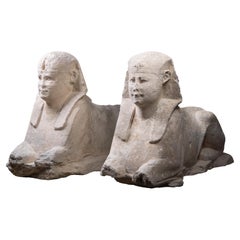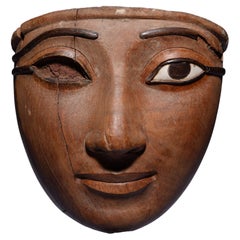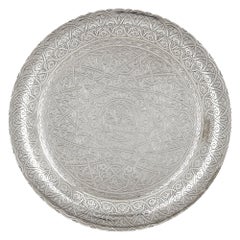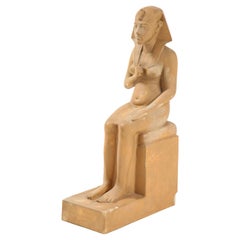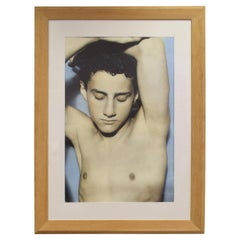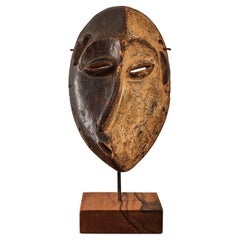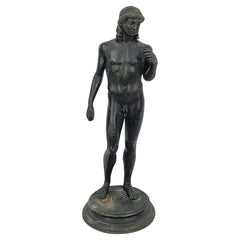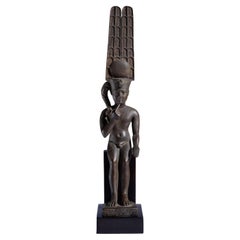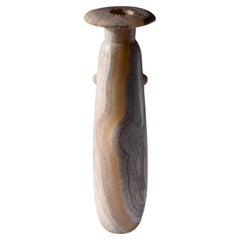Egyptian Furniture
9
1
1
to
1
7
3
11
10
10
1
1
4
1
4
2
2
2
1
1
4
4
3
2
1
20
49,536
15,639
10,803
8,934
1
1
Place of Origin: Egyptian
Recognized Seller Listings
Ancient Egyptian Monumental Temple Sphinxes
Located in London, GB
A pair of monumental limestone sphinxes of Pharaoh Nectanebo I, from the processional avenue of the Serapeum of Memphis, 30th Dynasty, circa 379 - 360 BC.
The sphinxes of the Serapeum have captivated travellers since Roman times. However, despite their significance, they are conspicuously absent from the collections of most major museums. Indeed, their existence in private hands is so improbable, and their imitations so numerous, that the present sphinxes were assumed to be modern copies throughout their recent ownership history. Finally recognised and conserved after an extraordinary chance discovery at a garden furniture sale...
Category
15th Century and Earlier Egyptian Antique Egyptian Furniture
Materials
Limestone
Exceptional Egyptian Sarcophagus Mask
Located in London, GB
Exceptionally Fine Wooden Sarcophagus Mask
Third Intermediate Period, 21st Dynasty, circa 1069-945 BC.
Acacia wood, rosewood, hippopotamus ivory
Masterfully carved from a single piece of fine-grained hardwood, the present mask is characteristic of the most exquisite funerary art made during the 21st Dynasty, and was probably commissioned for a particularly high-ranking individual.
The oval face displays a gently smiling mouth with full, outlined lips, furrows at the corners and a bow-shaped philtrum. The straight nose with rounded nostrils, the cheeks full and fleshy and the large, almond shaped eyes with heavy lids and tapering cosmetic lines, set below long, sweeping eyebrows.
Social collapse across the Mediterranean in the Late Bronze Age meant that the 21st Dynasty in Egypt was a period of great turmoil. Trade routes were disrupted, governments collapsed, and mass migration occurred. Economic scarcity meant that traditional funerary practices in Egypt were also affected, with a lack of material and financial resources leading to the reuse of preexisting material. As a result, during the 21st Dynasty, 19th and 20th Dynasty coffins changed ownership rapidly and were heavily recycled for new purposes. Tombs were also unmarked allowing them to be shared
by many people. These new practices brought forth a shift in the understanding of funerary paraphernalia. No longer important objects owned forever by the deceased, they were now simply seen as short-term transformative devices, whose symbolic and ritualistic meaning could be appropriated for others. However, paradoxically, the art of coffin-making also reached new heights during this period, and many of the richly dec- orated “yellow” coffins, characteristic of the 21st Dynasty, are remarkable works of art in their own right. Indeed, knowing that coffins were being reused throughout Egypt, the Egyptian élite set themself apart by commissioning lavish sarcophagi decorated with the images and texts meant to help guide them to the afterlife, and which would otherwise have adorned the tomb walls. As coffins were the chief funerary element which now identified the dead and allowed them a physical presence in the world of the living, their quality and appearance were of the utmost importance.
The traditional coffin ensemble was made of three parts: a wooden mummy cover, which laid directly atop the mummy, an inner coffin, and an outer coffin, both made of a lid and case. Additional decorative elements, such as masks, were carved out separately and later glued or pegged to the lids. After the completion of the painted decoration, the sarcophagus was covered in a varnish to give it its yellow colour. Gilding was sometimes used for the coffins of the high priests’ families, notably on parts representing naked skin, such as the face mask. However, some of the élite tactically avoided gilding altogether as to ensure that their coffin would not be looted.
When manufacturing the inner and outer coffins, particular attention was paid to the woodwork. Displaying the skill of the carpenter, this type of funerary art has largely remained unparalleled throughout Egyptian history. The principal wood used to craft the present mask is Acacia nilotica. The evergreen Egyptian acacia was considered sacred and said to be the tree of life, the birthplace of the god Horus, as well as symbolic of Osiris, the god of the dead and resurrection. The modelling of the face in the wood is superb, but the inlays also help mark this mask out as exceptional. Inlaid eyes and eyebrows were extremely rare and reserved to the finest and most expensive coffins. Traditionally, eyes were made of calcite, obsidian, or quartz, and eyebrows of coloured glass paste or bronze. Here, the pupils, eyebrows, and cosmetic lines are inlaid with Dalbergia melanoxylon, a rare type of wood which belongs to the rosewood genus.
In antiquity, however, it was known as Ebony of the Pharaohs, from the Egyptian word “hbny”, meaning dark timber, because of its black, lustrous appearance. An extremely dense and hard wood requiring significant skill to work with, ebony was a luxury material highly coveted by the pharaohs themselves, to make furniture, decorative and funerary objects. The wood was imported with great effort from the southern Land of Punt, most likely modern Sudan, Ethiopia, Djibouti, and Eritrea, alongside other luxury goods such as gold and ivory.
A magnificent ebony throne, recovered in the tomb of King Tutankhamun, illustrates the incredible aesthetic potential of this material and why it was so highly valued by Egyptian royalty. Only élite members of Egyptian society could have afford- ed Ebony of the Pharaoh inlays for their funerary mask.
The sclerae on the present piece were once both inlaid with hippopotamus ivory. Whiter than elephant ivory, this type of ivory is also denser, and more difficult to carve. The use of this luxury material, reputed for its gleaming appearance, enhances the lifelikeness of the eyes. For the Egyptians, hippopotamus ivory was imbued with magic powers. The hippopotamus was indeed both feared and venerated due to its aggressive behaviour. Whilst the male hippopotamus was associated with danger and chaos, the female was benevolent and invoked for protection, especially of the house and
of mothers and their children, through the hippopotamus goddess Tawaret. Thus, not only was hippopotamus ivory used as an inlay and to make practical objects, such as combs and clappers, but it was also used to make talismans like apotropaic wands or knives.
Made during a time of scarcity where few could afford made-to-order coffins, the present mask could have only belonged to one of the highest-ranking individuals in society. Undoubtedly one of the finest Egyptian coffin...
Category
15th Century and Earlier Egyptian Antique Egyptian Furniture
Materials
Fruitwood, Hardwood
Egyptian Head of a Man
Located in London, GB
Egyptian head of a man, carved granite. 18th Dynasty, circa 1550-1292 B.C.
Carved in beautiful dark granite, this head depicts an elite individual, perha...
Category
15th Century and Earlier Egyptian Antique Egyptian Furniture
Materials
Granite
Egyptian Engraved Silver Dish
Located in London, GB
Egyptian engraved silver dish
Egyptian, 1959-1961
Measures: Height 2cm, diameter 28.5cm
This fine, elegant bowl is wrought from silver, and features floral and geometric engravings all over, as well as a stepped rim and petal edge.
The underside is stamped with the Egyptian lotus...
Category
Mid-20th Century Egyptian Furniture
Materials
Silver
Grand Tour Statue of Pharaoh Hatshepsut After the Ancient Model
Located in Montreal, QC
Grand Tour statue of Pharaoh Hatshepsut after the ancient model.
Hatshepsut was the fifth pharaoh of the Eighteenth Dynasty of Egypt and was the second historically confirmed female pharaoh, the first being Sobekneferu. The authentic ancient sculpture of Hatshepsut is located in Deir el-Bahri, Thebes, Egypt. Cast painted plaster. Provenance: The Collection of Charles de Beistegui, Château de Groussay. Charles de Beistegui (1894-1970), an enigmatic interior decorator whose passport was Spanish and whose wealth came from his family’s Mexican silver mines. Beistegui to indulge himself in the homes he decorated, such as his Chateau de Groussay...
Category
Early 1900s Egyptian Antique Egyptian Furniture
Materials
Plaster
Yussef Nabil "Mohamed with Eyes Closed 2002" Digital Lambda Print, 'Signed'
Located in New York, NY
"Mohamed with Eyes Closed, 2002", large Digital Lambda Print, casting year 2001, Egypt (edition 1 of 3, signed, “Yussef Nabil 1/3 Cairo 2001” on back of photograph). The frame is sol...
Category
Early 2000s Modern Egyptian Furniture
Materials
Oak, Paint, Paper
Encapsulated Sculpture by Omar Chakil in Alabaster
By Omar Chakil
Located in Pireaus-Athens, Greece
Of Egyptian/Lebanese roots, Omar Chakil developed the series, Volutes, made of unvarnished, untreated, raw Egyptian alabaster which he calls Pharaonic alab...
Category
2010s Egyptian Furniture
Materials
Alabaster
Female Figurine Sculpture by Hassan Heshmat Egypt 1960s Blue Teal Stoneware
By Hassan Heshmat
Located in Stockholm, SE
Sculpture by Hassan Heshmat,
Egypt. 1960's.
Stoneware.
Unique.
Dimensions:
H: 52 cm/ 20 1/2''
Category
1960s Mid-Century Modern Vintage Egyptian Furniture
Materials
Stoneware
Egyptian Silver Wine Bucket, circa 1920
Located in Toronto, Ontario
Egyptian silver wine bucket, circa 1920. The bucket of tapered form, richly engraved with multiple hieroglyphic depictions and pyramids, figures, ho...
Category
Early 20th Century Egyptian Furniture
Materials
Silver
Medieval Egyptian Mamluk Brass Tray Stand with Silver Inlay
Located in London, GB
This exceptionally beautiful and rare silver-inlaid brass tray stand dates from the medieval period, when the Mamluks ruled Egypt and Syria (1250-1517). The Mamluks originated as sla...
Category
15th Century and Earlier Islamic Antique Egyptian Furniture
Materials
Brass, Silver
Pair of Egyptian Style Silver and Bronze Compotes
Located in New York, NY
Pair of Middle Eastern Egyptian-style (Late 19th Century) compotes with a silvered etched round top supported on a bronze pedestal resting on a triangular base. (PRICED AS Pair)
Category
19th Century Antique Egyptian Furniture
Materials
Bronze, Silver
Related Items
Pende Illness Mbangu Mask
Located in Long Island City, NY
Pende Illness Mbangu Mask on a wooden base.
Category
20th Century Egyptian Furniture
Materials
Wood
Grand Tour Bronze Statue Of Dionysus
Located in Bradenton, FL
19th century Grand Tour bronze statue of the ancient Greek Dionysus. Dionysus also known as Bacchus, was the god of wine, fertility and festiv...
Category
19th Century Grand Tour Antique Egyptian Furniture
Materials
Bronze
HEAVY ANTIQUE SiGNED GRAND TOUR BRONZE STATUE OF THE FOUR HORSES OF SAINT MARKS
Located in GB
Royal House Antiques
Royal House Antiques is delighted to offer for sale this stunning original Circa 1880 hand made in Italy Grand Tour bronze of the Horses of Saint Marks
This i...
Category
1880s Grand Tour Antique Egyptian Furniture
Materials
Bronze
H 6.3 in W 10.24 in D 6.11 in
Antique Persian Silver Engraved Box
Located in Rochester, NY
Antique Persian silver box. The box is beautifully chased, engraved and decorated with birds, animals and foliage. Circa 1900.
Category
Early 20th Century Egyptian Furniture
Materials
Silver
John Kacere Nude Prints
Located in Atlanta, GA
John Kacere nude prints, American, circa 1970s. The top print measures 18.25" H x 27.5" W. The bottom left measures 15" H x 23" W. The bottom right measures 14.75" H x 22" W. They ha...
Category
1970s Mid-Century Modern Vintage Egyptian Furniture
Materials
Glass, Wood, Paper
Vintage Pair of Egyptian Cream Recumbent Sphinxes 20th Century
Located in London, GB
This is a beautiful Vintage pair of French composite sculptures of Egyptian recumbent Sphinx, dating from the late 20th Century.
Each sphinx is modelled wearing a pharaonic headdre...
Category
Late 20th Century Egyptian Furniture
Materials
Other
After the Antique, Grand Tour Bronze of Aristotle
Located in Montreal, QC
The philosopher in oratorical pose, with an urn of his writings at his feet.
A 19th century casting, good crisp quality on marble base.
Category
1850s Classical Roman Antique Egyptian Furniture
Materials
Marble, Bronze
Antique English Sterling Silver Fruit Dish
By Daniel & John Welby
Located in London, GB
An antique English sterling silver fruit dish of oval form standing on four lion-mask feet. Made by D & J Welby and hallmarked London 1912.
Category
1910s Edwardian Vintage Egyptian Furniture
Materials
Sterling Silver
Ancient Egyptian Mask, 900-600 BCE
Located in Doylestown, PA
An ancient burial mask that was created to adorn a sarcophagus, 26th Dynasty, Minia, Mid-Upper Nile, circa 900-600BCE, from the collection of Joanna Barnes and Jack Warner, (Warner B...
Category
15th Century and Earlier Egyptian Antique Egyptian Furniture
Materials
Wood
Two-Headed Egyptian Sphinx Sculpture
Located in Asheville, NC
This two-headed Egyptian sphinx is constructed of solid wood. The wood has been treated to take on a sandy, almost marble, finish. Unlike the Greek sph...
Category
20th Century Egyptian Furniture
Materials
Wood
Set of Four Egyptian Antiquities, Pair of Sarcophagus Faience & Two Figurines
Located in New York, NY
This captivating authentic Egyptian Faience set was realized in ancient Egypt circa 3100 BCE. It offers two sarcophagus figurines- suggestive of miniature versions of King Tut's tomb- hand finished in a beautiful turquoise hue (a glaze created by pulverizing the stone into pigment). Additionally, the set features two figurines (one representative of the Egyptian god Anubis), and the other seemingly a depiction of one of the ruler's as a young child also in a turquoise glaze atop volumetric rhombus plinths with tapered sides in a refined terra cotta hue. Full of historical importance (and stunning as stand alone objects) this collection of Egyptian antiquities...
Category
15th Century and Earlier Egyptian Antique Egyptian Furniture
Materials
Faience
H 2 in W 1.25 in D 1.25 in
Collection of Typeset Advertising Print Blocks, C.1940
Located in San Francisco, CA
About
A collection of 17 small individual metal and wood typeset print blocks used in advertising. Sold as a set.
Creator: Unknown.
Date of manufacture: c.1940.
Materials ...
Category
Early 20th Century Industrial Egyptian Furniture
Materials
Metal
Previously Available Items
Ancient Egyptian Bronze Statue of Harpocrates
Located in London, GB
Egyptian Bronze Figurine of Harpocrates
Late Period, circa 664-30 B.C.
Bronze with silver inlay
Height: 23.1 cm
Harpocrates - that is, the infant Ho...
Category
15th Century and Earlier Egyptian Antique Egyptian Furniture
Materials
Bronze
Ancient Egyptian Alabaster Perfume Vessel
Located in London, GB
Beautifully Carved Alabastron
Fine-grained banded alabaster, likely from Egypt
Circa 6th-4th Century B.C.
‘‘And, behold, a woman in the city, which was a sinner, when she knew t...
Category
15th Century and Earlier Egyptian Antique Egyptian Furniture
Materials
Alabaster
Ancient Egyptian Bronze Statue of Ptah
Located in London, GB
An Egyptian Bronze Figure of Ptah
25th or early 26th Dynasty, circa 750-600 B.C.
“For the very great one is Ptah, who gave [life] to all the...
Category
15th Century and Earlier Egyptian Antique Egyptian Furniture
Materials
Bronze
Egyptian Relief of a Barn Owl
Located in London, GB
An exceptionally fine Egyptian limestone relief of a barn owl, 26th Dynasty/Ptolemaic Period, circa 664-30 B.C.
Carved in high relief, depicting the animal in profile with the creature’s head turned to face the viewer. The bird is shown with a triangular, pointed beak, its large round eyes framed by a spray of feathers, the borders of the face, the forehead, the body and the top of the wing delicately carved with minutely detailed plumage. This small masterpiece is the work of a particularly skilled and talented sculptor and is among the finest Egyptian representations of owls in private hands. Late Dynastic and Ptolemaic limestone plaques...
Category
15th Century and Earlier Egyptian Antique Egyptian Furniture
Materials
Limestone
Egyptian Bronze Horus Falcon Statue
Located in London, GB
An Egyptian bronze Horus falcon, Late Period, circa 716-30 B.C.
“I am Horus, the great Falcon... My flight has reached the horizon... I have gone further than the gods of old. Even the most ancient...
Category
15th Century and Earlier Egyptian Antique Egyptian Furniture
Materials
Bronze
Vintage Missoni Masters Tulip Design Hand Woven Wool Rug by T & J Vestor 1980's
By MissoniHome
Located in Milan, IT
A very finely hand knotted rug designed for Missoni by T & J Vestor for the Missoni Masters collection, launched during the early 80's. The pattern consists of an abstract rendition ...
Category
1980s Mid-Century Modern Vintage Egyptian Furniture
Materials
Wool
W 48.43 in L 72.45 in
Egyptian Limestone Cartouche of Ramesses the Great, 1279 BC
Located in London, GB
Egyptian limestone relief fragment with cartouches for Ramesses the Great, New Kingdom, 19th dynasty, circa 1279-1213 BC.
The cartouches carved in ...
Category
15th Century and Earlier Egyptian Antique Egyptian Furniture
Materials
Limestone
Free Shipping
H 11.75 in W 9.75 in D 3.75 in
Ancient Egyptian New Kingdom Shabti for Iuferbaku
Located in London, GB
Finely carved in wood with remnants of blue and gold gesso, this beautiful mummiform shabti was deposited in the tomb of Iuferbaku to act as his servant in the afterlife and perform ...
Category
15th Century and Earlier Egyptian Antique Egyptian Furniture
Materials
Wood
Ancient Egyptian Stone Bust of Bes, 332 BC
Located in London, GB
Quartzite bust of Bes, guardian of the household, patron of childbirth and god of war. Dating to Egypt's Ptolemaic Period, circa 332 - 30 BC.
The rounded head with large, oval ey...
Category
15th Century and Earlier Egyptian Antique Egyptian Furniture
Materials
Stone
Egyptian Paleolithic Tools from the Theban Plateau
Located in London, GB
A collection of Homo erectus tools from the Theban plateau, Egypt, dating to the Lower Paleolithic, circa 300,000-90,000 years ago.
Cf. object 06.322.14 at the Metoropiltan Museum...
Category
15th Century and Earlier Antique Egyptian Furniture
Materials
Stone
Ancient Greek Silver Tetradrachm Coin of King Ptolemy I, 300 BC
Located in London, GB
A silver tetradrachm issued by Ptolemy I Soter (Saviour), circa 300-285 BC, Alexandria mint.
The obverse with the head of Ptolemy, in bold Hellenistic style; the wild curls of his...
Category
15th Century and Earlier Classical Greek Antique Egyptian Furniture
Materials
Silver
Vintage Egyptian Silver Photograph Frame, 1951
Located in Jesmond, Newcastle Upon Tyne
An exceptional, fine and impressive vintage Egyptian 900 standard silver photograph frame in the Art Deco style, an addition to our ornamental silverware collection.
This exceptional vintage Egyptian silver photo frame has an arched shaped form with a paralleling internal window, in the Art Deco style.
The lower portion of the photograph frame is ornamented with a horizontal segment, conjoined to the main body with a tri-lobed collar, all in the iconic Art Deco style.
The convex surface of this photo frame is plain and unembellished.
This photograph frame retains the original painted wood back and hinged strut, secured with a hallmarked swivel catch, the hallmarked silver portions securing the wood back, in addition to the catches indicates the high quality of the piece.
This vintage Egyptian silver photo frame is inset with a removable glass panel.
The hallmarks struck to the posterior surface of the frame include:
Assay mark: Arabic characters (Cairo, Egypt)
Silver quality/purity mark: .900 (900/1000)
National mark: Lotus flower
Date letter: Ø° (1951)
The use of the lotus flower (post 1946), in addition to the marking identified as Ø° through illustrations available of isolated form Arabic lettering determines the date of this piece as 1951.
Condition
This vintage Art Deco...
Category
1950s Art Deco Vintage Egyptian Furniture
Materials
Silver, Sterling Silver
Recently Viewed
View AllMore Ways To Browse
Brass And Glass Display Shelves
Chain Knot
Painted Commode Antique
Bow Chest Of Drawers
Brass Antique Door Hinges
Burl Chest With Drawers
Wooden Front Doors
Art Nouveau Dealers
Bronze Display Case
Bright White 1960s
Blue Painted Furniture Chest
Walnut Double Door
Upholstered Case Pieces
Century Furniture Hutch
Wood Box With Drawers
Brass Hardware Cabinet Pull
Antique French Marble Chest Of Drawers
Vintage Flower Black
